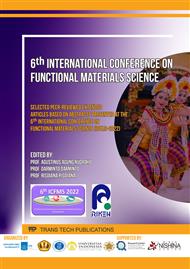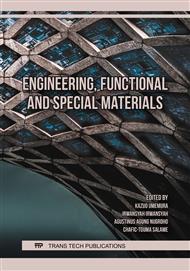[1]
C.N. Wang, J.H. Torng, Experimental study of the absorption characteristics of some porous fibrous materials, Appl. Acoust. 62 (2001) 447–459.
DOI: 10.1016/s0003-682x(00)00043-8
Google Scholar
[2]
L. Lipworth, C. La Vecchia, C. Bosetti, J.K. McLaughlin, Occupational exposure to rock wool and glass wool and risk of cancers of the lung and the head and neck: A systematic review and meta-analysis, J. Occup. Environ. Med. 51 (2009) 1075–1087.
DOI: 10.1097/jom.0b013e3181b35125
Google Scholar
[3]
C. Elanchezhian, B.V. Ramnath, G. Ramakrishnan, M. Rajendrakumar, V. Naveenkumar, M.K. Saravanakumar, Review on mechanical properties of natural fiber composites., Mater. Today Proc. 5 (2018) 1785–1790.
DOI: 10.1016/j.matpr.2017.11.276
Google Scholar
[4]
M. Hosseini Fouladi, M. Ayub, M. Jailani Mohd Nor, Analysis of coir fiber acoustical characteristics, Appl. Acoust. 72 (2011) 35–42.
DOI: 10.1016/j.apacoust.2010.09.007
Google Scholar
[5]
N.H. Sari, I.N.G. Wardana, Y.S. Irawan, E. Siswanto, Corn Husk Fiber-Polyester Composites as Sound Absorber : Nonacoustical and Acoustical Properties, 2017 (2017).
DOI: 10.1155/2017/4319389
Google Scholar
[6]
A. Putraa, Y. Abdullaha, H. Efendya, W.M. Farida, R. Ayoba, M.S. Pya, Utilizing Sugarcane Wasted Fibers As A Sustainable Acoustic Absorber, 53 (2013) 632–638.
Google Scholar
[7]
Z.Y. Lim, A. Putra, M.J.M. Nor, M.Y. Yaakob, Sound absorption performance of natural kenaf fi bres, Appl. Acoust. 130 (2018) 107–114..
DOI: 10.1016/j.apacoust.2017.09.012
Google Scholar
[8]
C.O.B. Mendes, M.A. de Araújo Nunes, Acoustic performance of the banana pseudostem fiber, Appl. Acoust. 191 (2022).
DOI: 10.1016/j.apacoust.2022.108657
Google Scholar
[9]
R.R. Dancel, Abaca Fiber as a Retrofitting Material, Proc. Res. Int. Conf. (2018) 1–5.
Google Scholar
[10]
E.A. Simbaña, P.E. Ordóñez, Y.F. Ordóñez, V.H. Guerrero, M.C. Mera, E.A. Carvajal, Abaca: Cultivation, obtaining fibre and potential uses, Handb. Nat. Fibres Second Ed. 1 (2020) 197–218.
DOI: 10.1016/b978-0-12-818398-4.00008-6
Google Scholar
[11]
A.K. Bledzki, A. Jaszkiewicz, D. Scherzer, Mechanical properties of PLA composites with man-made cellulose and abaca fibres, Compos. Part A Appl. Sci. Manuf. 40 (2009) 404–412.
DOI: 10.1016/j.compositesa.2009.01.002
Google Scholar
[12]
B. Vijaya Ramnath, S. Junaid Kokan, R. Niranjan Raja, R. Sathyanarayanan, C. Elanchezhian, A. Rajendra Prasad, V.M. Manickavasagam, Evaluation of mechanical properties of abaca-jute-glass fibre reinforced epoxy composite, Mater. Des. 51 (2013) 357–366.
DOI: 10.1016/j.matdes.2013.03.102
Google Scholar
[13]
A.K. Bledzki, A.A. Mamun, A. Jaszkiewicz, K. Erdmann, Polypropylene composites with enzyme modified abaca fibre, Compos. Sci. Technol. 70 (2010) 854–860.
DOI: 10.1016/j.compscitech.2010.02.003
Google Scholar
[14]
F. Vilaseca, A. Valadez-Gonzalez, P.J. Herrera-Franco, M.À. Pèlach, J.P. López, P. Mutjé, Biocomposites from abaca strands and polypropylene. Part I: Evaluation of the tensile properties, Bioresour. Technol. 101 (2010) 387–395.
DOI: 10.1016/j.biortech.2009.07.066
Google Scholar
[15]
A. Kumar Sinha, H.K. Narang, S. Bhattacharya, Evaluation of Bending Strength of Abaca Reinforced Polymer Composites, Mater. Today Proc. 5 (2018) 7284–7288.
DOI: 10.1016/j.matpr.2017.11.396
Google Scholar
[16]
R. Punyamurthy, D. Sampathkumar, B. Bennehalli, R. Patel, S.C. Venkateshappa, Abaca Fiber Reinforced Epoxy Composites : Evaluation of Impact Strength International Journal of Sciences : Abaca Fiber Reinforced Epoxy Composites : Evaluation of Impact Strength, Int. J. Sci. Basic Appl. Res. (2014) 305–317. http://gssrr.org/index.php?journal= JournalOfBasicAndApplied.
DOI: 10.1016/j.ctmat.2015.03.003
Google Scholar
[17]
S. Sambandamoorthy, V. Narayanan, L.B.M. Chinnapandi, A. Aziz, Impact of fiber length and surface modification on the acoustic behaviour of jute fiber, Appl. Acoust. 173 (2021).
DOI: 10.1016/j.apacoust.2020.107677
Google Scholar
[18]
U. Berardi, G. Iannace, Acoustic characterization of natural fibers for sound absorption applications, Build. Environ. 94 (2015) 840–852.
DOI: 10.1016/j.buildenv.2015.05.029
Google Scholar
[19]
U. Berardi, G. Iannace, Acoustic characterization of natural fibers for sound absorption applications, Build. Environ. 94 (2015) 840–852.
DOI: 10.1016/j.buildenv.2015.05.029
Google Scholar



